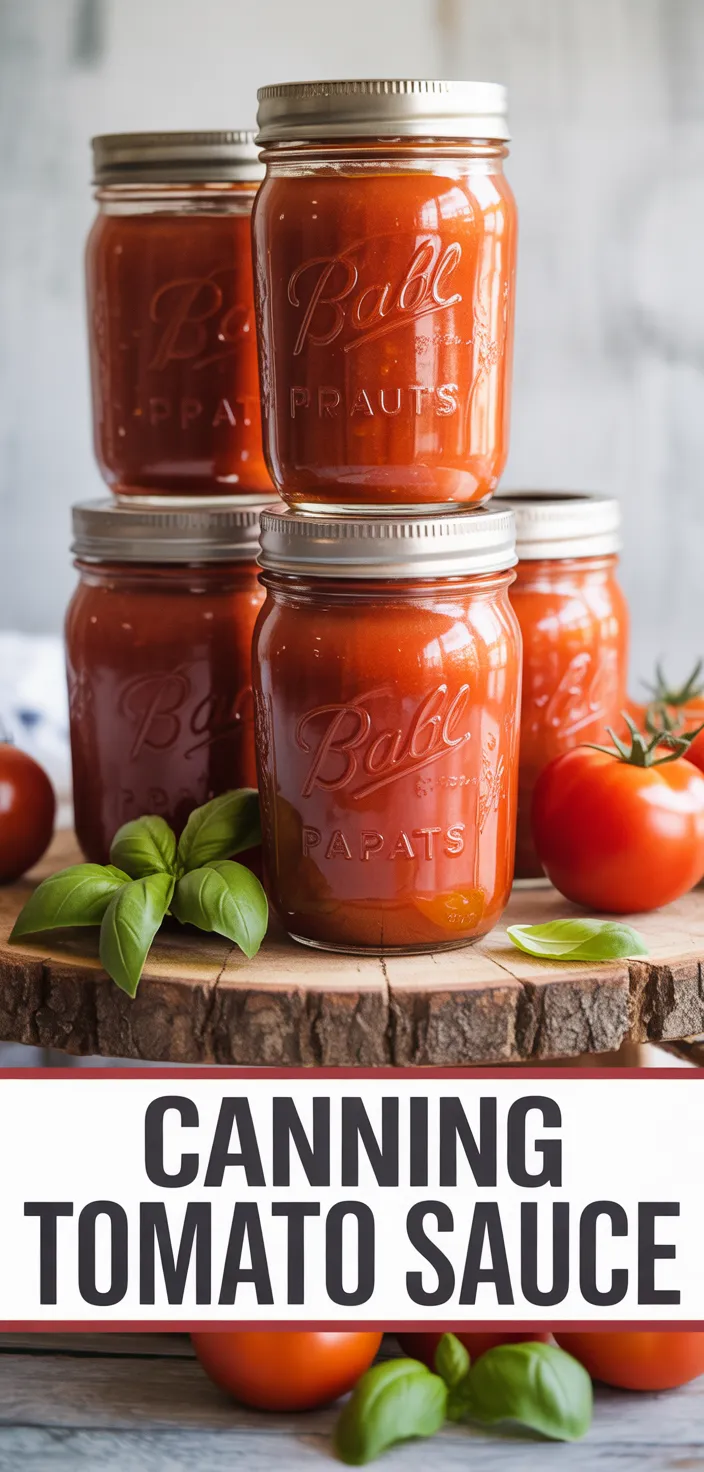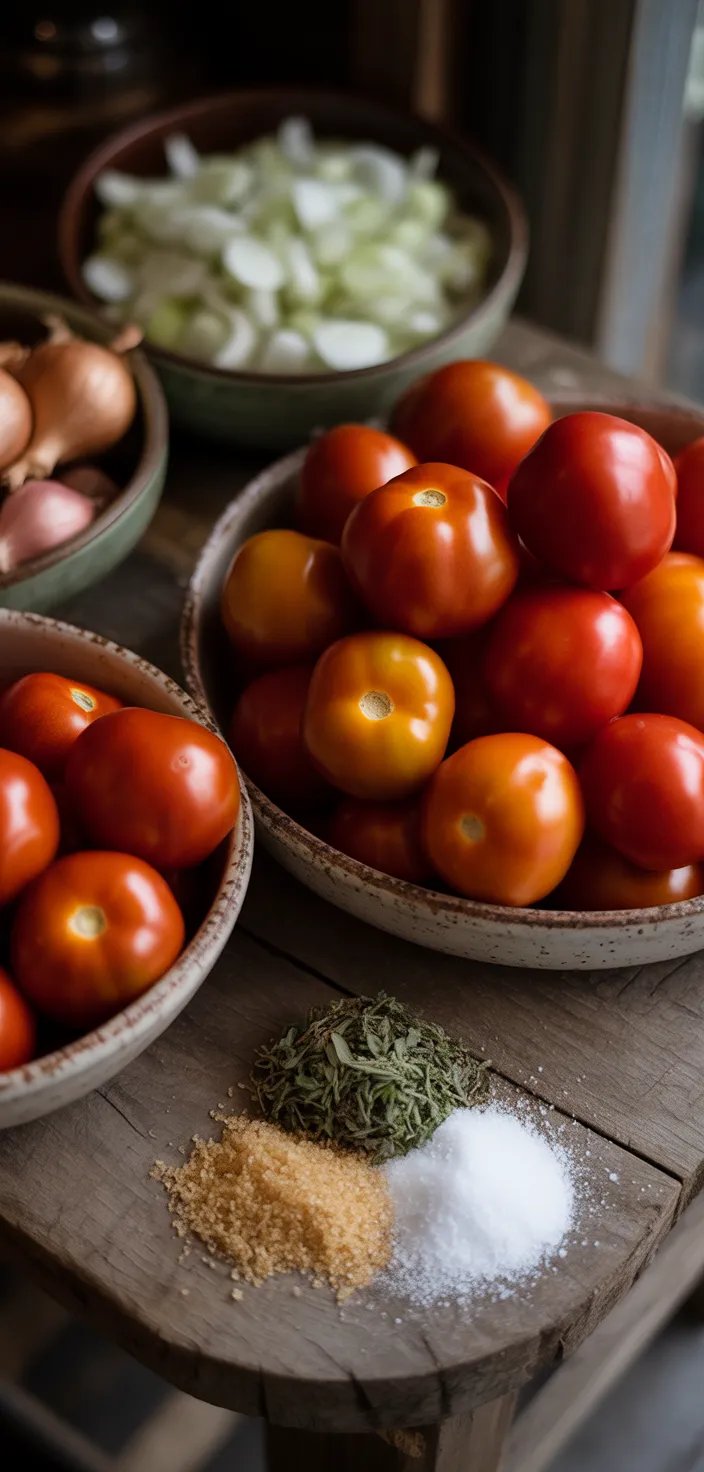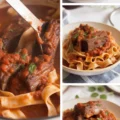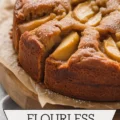I’ve compiled Water Bath Canning Recipes for tomato sauce plus a handful of clever tips to help you manage a summer tomato glut and stock your pantry with jars.

I used to shrug at jars from the grocery until I tasted sauce made from ripe Roma tomatoes and fresh garlic. Suddenly store-bought seemed flat and dull.
Canning tomato sauce turns an overload of summer fruit into something fierce and useful, not just another jar in the pantry. I’ll show you why the smell alone will make you drop whatever you were doing and scrape the pot clean.
Curious about preserving that summer punch for winter dinners? This is exactly the sort of thing I’d call Canning Roma Tomatoes Marinara Sauce — messy, a little bold, and totally worth the effort.
Ingredients

- Tomatoes: juicy, full of vitamin C and fiber, add sweet and bright acidity
- Acidifier: keeps sauce safe for canning, gives tangy sour flavor
- Salt: enhances flavor, modest sodium, helps balance tomatoes sweetness
- Sugar: tones acidity, adds sweetness, optional if tomatoes are tart
- Onions: give savory depth, small fiber, some vitamin C, theyre mellow
- Garlic: punchy aromatics, trace protein, boosts savory, can be strong
- Basil: herbal sweetness, little calories, adds classic Italian flavor, aromatic
- Oregano: earthy, bitter herb, good for depth, pairs well with basil
Ingredient Quantities
- 25 pounds ripe tomatoes (Roma or paste varieties) yields about 7 to 8 quarts sauce
- Bottled lemon juice, 2 tablespoons per quart (for 7 quarts about 14 tablespoons) or citric acid (food grade), 1/2 teaspoon per quart (for 7 quarts about 3 1/2 teaspoons)
- Salt, 1 teaspoon per quart optional (for 7 quarts about 7 teaspoons)
- Granulated sugar, 1 teaspoon per quart optional (for 7 quarts about 7 teaspoons)
- Onions, 2 to 3 medium onions per 25 pounds batch optional
- Garlic, 4 to 6 cloves per 25 pounds batch optional
- Dried basil, 1 to 2 teaspoons per quart optional
- Dried oregano, 1 teaspoon per quart optional
How to Make this
1. Sort and wash about 25 pounds ripe Roma or paste tomatoes, core and cut out bad spots; blanch in boiling water 30 to 60 seconds then plunge into ice water so the skins slip off easily.
2. Quarter peeled tomatoes, remove large cores if any, then simmer in a very large pot until soft and broken down, about 20 to 30 minutes; add 2 to 3 medium chopped onions and 4 to 6 crushed garlic cloves now if you want them in the batch.
3. For a smooth sauce push the cooked tomatoes through a food mill or blend briefly and return to the pot; simmer longer to reduce to your preferred thickness, stir often so it does not scorch.
4. Season the hot sauce now: add dried basil 1 to 2 teaspoons per quart and dried oregano 1 teaspoon per quart, and taste for salt and sweetness; if using salt add about 1 teaspoon per quart (for 7 quarts about 7 teaspoons) and sugar 1 teaspoon per quart (for 7 quarts about 7 teaspoons) if needed. Remember flavors concentrate while simmering, so don’t overdo it.
5. Prep jars, lids and bands: wash jars, keep them hot in simmering water or dishwasher to prevent breakage; have new flat lids ready. Before filling each jar, add bottled lemon juice 2 tablespoons per quart (for 7 quarts about 14 tablespoons) or food grade citric acid 1/2 teaspoon per quart (for 7 quarts about 3 1/2 teaspoons) to ensure safe acidity.
6. Ladle the hot sauce into hot jars, leaving 1/2 inch headspace for quarts and pints; add the optional salt or sugar amounts per quart now if you didn’t mix them into the pot; remove air bubbles with a nonmetallic spatula, wipe rims clean and place lids and screw bands fingertip tight.
7. Place jars in a boiling water bath canner with at least 1 to 2 inches of water over the tops, bring to a full rolling boil and process pints 35 minutes, quarts 45 minutes at sea level. If you live higher, add processing time per USDA altitude guidance: add 5 minutes for 1,001 to 3,000 ft, 10 minutes for 3,001 to 6,000 ft, 15 minutes for 6,001 to 8,000 ft, 20 minutes above 8,000 ft.
8. When time is up turn off heat, remove canner lid and wait 5 minutes, then lift jars out and set them on a towel in a draft free spot to cool 12 to 24 hours; you should hear the satisfying ping as lids seal.
9. After cooling, check seals, remove bands, wash and dry jars, label with date and contents; store in a cool dark place for up to a year. Any jars that did not seal must be refrigerated and used within a week or reprocessed within 24 hours.
Equipment Needed
1. Very large stockpot (16 to 20 quart) for simmering the whole batch
2. Large pot for blanching tomatoes and a big heatproof bowl for the ice water bath
3. Food mill (best) or a high-speed blender plus a fine mesh strainer if you dont have a mill
4. Wide-mouth canning funnel and a heatproof ladle for easy, less-mess filling
5. Canning jars with new flat lids and screw bands (pints or quarts as you prefer)
6. Boiling water bath canner or a large stockpot with a rack to keep jars off the bottom
7. Jar lifter and a magnetic lid lifter or tongs to handle hot jars and lids safely
8. Long-handled wooden spoon for stirring and a nonmetallic spatula to remove air bubbles
9. Measuring spoons and a small measuring cup for lemon juice or citric acid, plus a clean towel to wipe rims and set jars on while they cool
FAQ
Canning Tomato Sauce Recipe Substitutions and Variations
- Tomatoes: if you can’t get 25 pounds fresh, use canned crushed tomatoes or tomato puree. Plan on about 7 quarts sauce = roughly eight 28‑oz cans of crushed tomatoes. They’ll save time, just taste and cook down if it’s too thin.
- Bottled lemon juice / citric acid: you can swap one for the other. Use 2 tablespoons bottled lemon juice per quart or 1/2 teaspoon food‑grade citric acid per quart. Do not rely on fresh squeezed lemons for safely canning tomatoes.
- Onions: try shallots, leeks, or onion powder. For a 25 lb batch (2–3 medium onions) use about 6–9 small shallots, 1 1/2 to 2 cups sliced leeks, or start with 2–3 tablespoons onion powder and adjust to taste.
- Dried basil and oregano: swap with fresh herbs at about 3 times the dried amount. So 1–2 teaspoons dried basil per quart becomes 1–2 tablespoons fresh chopped, and 1 teaspoon dried oregano becomes about 1 tablespoon fresh. Or use 1 teaspoon Italian seasoning in place of the two dried herbs combined.
Pro Tips
1) Always acidify each jar correctly: put 2 tablespoons bottled lemon juice or 1/2 teaspoon food grade citric acid into each quart jar before you fill it. Dont use fresh squeezed lemons, their acid level can change and that can be unsafe.
2) Stop scorching and speed up reduction by using a wide, heavy bottom pot and moderate heat, stir often, and scrape the bottom with a wooden spoon as you go. If it starts to cling add a little hot water, dont crank the heat to burn off liquid.
3) Keep everything hot and leave the right headspace, then tighten lids only fingertip tight so air can escape while processing. Wipe rims clean before sealing, a speck of sauce will keep a jar from sealing.
4) Season lightly before canning because flavors concentrate as the sauce cooks down, you can always adjust salt or sugar when you open a jar later. If you want fresh herb flavor, stir in fresh basil after reheating a jar rather than canning it in, it holds the bright taste better.

Canning Tomato Sauce Recipe
I’ve compiled Water Bath Canning Recipes for tomato sauce plus a handful of clever tips to help you manage a summer tomato glut and stock your pantry with jars.
56
servings
42.2
kcal
Equipment: 1. Very large stockpot (16 to 20 quart) for simmering the whole batch
2. Large pot for blanching tomatoes and a big heatproof bowl for the ice water bath
3. Food mill (best) or a high-speed blender plus a fine mesh strainer if you dont have a mill
4. Wide-mouth canning funnel and a heatproof ladle for easy, less-mess filling
5. Canning jars with new flat lids and screw bands (pints or quarts as you prefer)
6. Boiling water bath canner or a large stockpot with a rack to keep jars off the bottom
7. Jar lifter and a magnetic lid lifter or tongs to handle hot jars and lids safely
8. Long-handled wooden spoon for stirring and a nonmetallic spatula to remove air bubbles
9. Measuring spoons and a small measuring cup for lemon juice or citric acid, plus a clean towel to wipe rims and set jars on while they cool
Ingredients
-
25 pounds ripe tomatoes (Roma or paste varieties) yields about 7 to 8 quarts sauce
-
Bottled lemon juice, 2 tablespoons per quart (for 7 quarts about 14 tablespoons) or citric acid (food grade), 1/2 teaspoon per quart (for 7 quarts about 3 1/2 teaspoons)
-
Salt, 1 teaspoon per quart optional (for 7 quarts about 7 teaspoons)
-
Granulated sugar, 1 teaspoon per quart optional (for 7 quarts about 7 teaspoons)
-
Onions, 2 to 3 medium onions per 25 pounds batch optional
-
Garlic, 4 to 6 cloves per 25 pounds batch optional
-
Dried basil, 1 to 2 teaspoons per quart optional
-
Dried oregano, 1 teaspoon per quart optional
Directions
- Sort and wash about 25 pounds ripe Roma or paste tomatoes, core and cut out bad spots; blanch in boiling water 30 to 60 seconds then plunge into ice water so the skins slip off easily.
- Quarter peeled tomatoes, remove large cores if any, then simmer in a very large pot until soft and broken down, about 20 to 30 minutes; add 2 to 3 medium chopped onions and 4 to 6 crushed garlic cloves now if you want them in the batch.
- For a smooth sauce push the cooked tomatoes through a food mill or blend briefly and return to the pot; simmer longer to reduce to your preferred thickness, stir often so it does not scorch.
- Season the hot sauce now: add dried basil 1 to 2 teaspoons per quart and dried oregano 1 teaspoon per quart, and taste for salt and sweetness; if using salt add about 1 teaspoon per quart (for 7 quarts about 7 teaspoons) and sugar 1 teaspoon per quart (for 7 quarts about 7 teaspoons) if needed. Remember flavors concentrate while simmering, so don’t overdo it.
- Prep jars, lids and bands: wash jars, keep them hot in simmering water or dishwasher to prevent breakage; have new flat lids ready. Before filling each jar, add bottled lemon juice 2 tablespoons per quart (for 7 quarts about 14 tablespoons) or food grade citric acid 1/2 teaspoon per quart (for 7 quarts about 3 1/2 teaspoons) to ensure safe acidity.
- Ladle the hot sauce into hot jars, leaving 1/2 inch headspace for quarts and pints; add the optional salt or sugar amounts per quart now if you didn’t mix them into the pot; remove air bubbles with a nonmetallic spatula, wipe rims clean and place lids and screw bands fingertip tight.
- Place jars in a boiling water bath canner with at least 1 to 2 inches of water over the tops, bring to a full rolling boil and process pints 35 minutes, quarts 45 minutes at sea level. If you live higher, add processing time per USDA altitude guidance: add 5 minutes for 1,001 to 3,000 ft, 10 minutes for 3,001 to 6,000 ft, 15 minutes for 6,001 to 8,000 ft, 20 minutes above 8,000 ft.
- When time is up turn off heat, remove canner lid and wait 5 minutes, then lift jars out and set them on a towel in a draft free spot to cool 12 to 24 hours; you should hear the satisfying ping as lids seal.
- After cooling, check seals, remove bands, wash and dry jars, label with date and contents; store in a cool dark place for up to a year. Any jars that did not seal must be refrigerated and used within a week or reprocessed within 24 hours.
Notes
- Below you’ll find my best estimate of this recipe’s nutrition facts. Treat the numbers as a guide rather than a rule—great food should nourish both body and spirit. Figures are approximate, and the website owner assumes no liability for any inaccuracies in this recipe.
Nutrition Facts
- Serving Size: 118g
- Total number of serves: 56
- Calories: 42.2kcal
- Fat: 0.43g
- Saturated Fat: 0.06g
- Trans Fat: 0g
- Polyunsaturated: 0.16g
- Monounsaturated: 0.06g
- Cholesterol: 0mg
- Sodium: 286mg
- Potassium: 492mg
- Carbohydrates: 9.33g
- Fiber: 2.55g
- Sugar: 6.12g
- Protein: 1.91g
- Vitamin A: 1687IU
- Vitamin C: 29.7mg
- Calcium: 22.4mg
- Iron: 0.63mg







